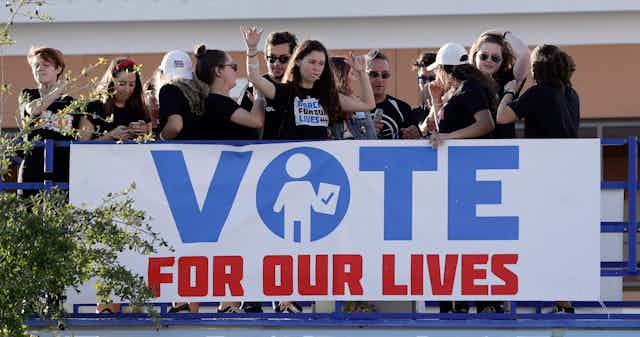Youth turnout in the recent United States midterm elections was the highest it has been in 25 years. The midterms also saw the average age of congressional representatives go down by 10 years.
Likewise, in the 2015 Canadian federal election, 58 per cent of newly eligible voters turned out to vote, an increase of almost 18 per cent over the 2011 election.
There have been similar increases in voting among 18- to 24-year-olds in provincial elections. Dramatic wins in 2015 for the NDP in Alberta and British Columbia can be attributed in part to youth voting, because younger voters lean progressive.
Young voters in Canada have shown up for parties focused on issues that are important to their generation, in particular climate change, diversity, equality and the regulatory role of government.
Youth movements, in fact, are playing a role in voter turnout. The U.S. March for our Lives movement aims to end gun violence. The movement’s protests in March of this year attracted an estimated two million youth, and extended into the Vote for Our Lives campaign.
Vote for our Lives began by registering thousands of youth voters at the March for Our Lives protests, and carried the momentum into the midterms, likely playing a part in the youth voting surge.
‘Maple Spring’
There have been many other notable youth movements in North America. The 2012 Québec “Maple Spring” student movement, ignited by a provincial government decision to hike tuition, was at the time described as among the largest youth movements in North America since the 1960s.

An Ontario youth protest against changes to the sex education curriculum in 2018 drew tens of thousands of youth. Indigenous youth protests across North America have focused on topics such as pipelines, clean water and unjust deaths.
The United Nations Convention on the Rights of the Child (UNCRC) gives children and youth the right to participate in decision-making in matters that affect them, including in political and community contexts.
More than this, the UN convention gives them the right to informed decision-making, which means that adults are legally obligated to educate youth. This includes, for example, laws and requirements about school rules, health care and education. Adults must explain these issues, consult with youth and take their views into account.
The UNCRC was signed by all United Nations member states, including the U.S., although the U.S. stands alone in failing to ratify it.
Even without the UNCRC, democracy requires considering the views of all citizens. Citizens have rights and obligations, including voting and service; young voters should not be excluded.
Cultural critic Henry Giroux, who writes extensively on education and politics, has defined citizens as people with the “capacity not only to understand and engage the world but to transform it when necessary, and to believe that he or she can do that.” That means we need youth to participate even before they’re old enough to vote.
The huge benefits of youth engagement
In our own research with the Centre of Excellence for Youth Engagement, we have found widespread benefits from youth’s civic engagement and advocacy. Young people gain new skills when they become engaged politically, and they learn to take on greater responsibility. They also learn more about who they are and what they value in life. They gain a sense of their unique abilities to make a difference.

If they participate when they are young, they are also more likely to participate later on. Adults also benefit by learning from youth, and society benefits from the new ideas and the fresh perspective of young people, as well as from their future participation.
Is this enough to make policy-makers, politicians and broader society pay attention to young people? It should be, but there are also strategic political reasons to pay attention to youth.
Youth make up a substantial proportion of the voting populations. In Canada, millennials will soon be the largest age cohort within the electorate. Many young people who are not old enough to vote are still active in protests and advocacy.
Can influence election outcomes
Youth have the potential to significantly impact the outcome of elections. Strategies that encourage their participation can help further their influence. Youth should be consulted during the development of party platforms, and advise politicians on strategies that will reach their peers.
Youth advisory councils for political candidates would also help make campaigns more engaging to youth. Barriers to youth participation should also be addressed. Like adults, youth report lack of time as their No. 1 reason for not voting. Unlike adults, however, their second most common reason for failing to cast a ballot is a lack of information about the candidates and issues, perhaps because they get information primarily from social media.
What does it all mean?
Young people want information as elections loom. Given that social media use is almost universal for this age group, there is an opportunity to responsibly share information through their preferred social media and networks.
We might also explore innovative ways to capitalize on their leadership in drawing other citizens into the political process. For example, Vote for Our Lives organizers created a T-shirt with a QR code that allows people to register to vote by just scanning the code with their phone.
Youth have the right, the skills and the numbers to “make a difference” in government and society. Decision-makers would be wise to meaningfully engage with young people and acknowledge the importance of their voices, energy and vision to a healthy democracy.

